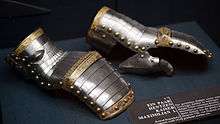Gauntlet (glove)



Gauntlet /ˈɡɔːntlɪt/[1] is a name for several different styles of glove, particularly those with an extended cuff covering part of the forearm. Gauntlets exist in many forms, ranging from flexible fabric and leather gloves, to mail and fully articulated plate armour.
Types
Armour
Historically, gauntlets were used by soldiers and knights. It was considered an important piece of armour, since the hands and arms were particularly vulnerable in hand-to-hand combat. With the rise of easily reloadable and effective firearms, hand-to-hand combat fell into decline along with personal armour, including gauntlets.
Some medieval gauntlets had a built-in knuckle duster. When the hand was bunched into a fist the backhand protection becomes pronounced from the fist just above the knuckles. This allowed the user to utilize the gauntlet as a melee weapon while still protecting the hand from damage when punching. However, against an armed combatant the use of this feature would have been risky, so it was very unlikely that a gauntlet would have been used in this way when a more suitable weapon was within reach. But if the user had no other means to defend themselves the tactics they would have employed would be to attempt to surprise the opponent with this inconspicuous attack, possibly by dodging and countering, aiming for exposed areas of flesh such as the face or weak areas of armour, such as under the arm or the groin.
A "Demi-gauntlet" (also called a "demi-gaunt" for short) is a type of plate armour gauntlet that only protects the back of the hand and the wrist; demi-gaunts are worn with gloves made from mail or padded leather. The advantages of the demi-gaunt are that it allows better dexterity and is lighter than a full gauntlet, but the disadvantage is that the fingers are not as well protected.
Sport, industry and science

Today, gauntlets are mostly used as armour in contact sports, such as fencing, sword fighting reenactments (such as the Society for Creative Anachronisms) and falconry. In industry, gauntlets are commonly used to protect workers from sparks when welding or grinding metal or when handling potentially harmful substances. Protective gauntlets are also sometimes worn by automotive technicians and butchers. Furthermore, they are an integral part of pressure suits and spacesuits, usually made of kevlar or other materials that combine toughness, environmental protection and flexibility. Gauntlets are also provided on some motorcyclist's leather gloves and on snowmobile driver's nylon mittens.
Drum corps and marching band
Marching band and drum corps uniforms often include an item called a "gauntlet" which includes no glove for the hand, but is just a flared cuff. Some versions are closer to bracers or vambraces in style.
Fashion
In the clothing industry gauntlet can refer to a fashion accessory which is just an extended cuff with little or no hand covering. Very popular with fans of Heavy Metal music.[2]
Religious
In the Roman Catholic Church the gloves traditionally worn by the pope or other bishops are also known as gauntlets,[3] or episcopal gloves, though their use had largely been relaxed since Paul VI.
Idioms
"Throw down the gauntlet"

To "throw down the gauntlet" is to issue a challenge. A gauntlet-wearing knight would challenge a fellow knight or enemy to a duel by throwing one of his gauntlets on the ground. The opponent would pick up the gauntlet to accept the challenge. The phrase is associated particularly with the action of the King's Champion, which officer's role was from medieval times to act as champion for the King at his coronation, in the unlikely event that someone challenged the new King's title to the throne.
"Run the gauntlet"
"Running the gauntlet" was a military punishment in which a soldier or sailor had to pass between a double row of comrades armed with cudgels. The expression is now generally used metaphorically. Gauntlet in this context is unrelated to the "protective glove" meaning, but is instead derived from the Swedish gatlopp ("street run").[4] Because of this difference in the derivation of the word, the expression is sometimes written "running the gantlet." In the American West, when an opponent, whether a white person or a Native American from an enemy tribe was captured, the prisoner was given the option of 'running the gauntlet', not unlike the military punishment mentioned above. Supposedly, if the prisoner could successfully navigate the gauntlet, he was allowed to go free. Usually, however, prisoners had to run for their lives.
Notes and references
- ↑ "the definition of gauntlet".
- ↑ Wedding Planning: Wedding Accessories - Gloves|Bridges.com Gauntlet Glove
- ↑ Roman Catholic Vestments The Gauntlets, 23
- ↑ Online Etymology Dictionary gauntlet (2)
External links
![]() Media related to Gauntlets at Wikimedia Commons
Media related to Gauntlets at Wikimedia Commons
